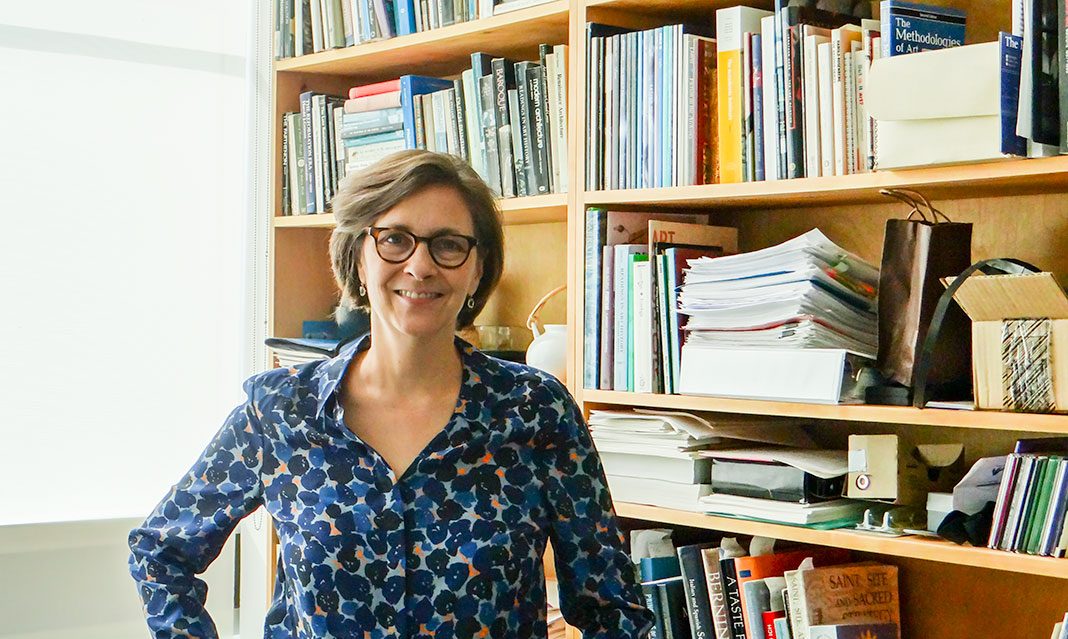In the year between high school and university, Evonne Levy, a professor of Renaissance and Baroque Art and Architecture at UTM, travelled to Italy where she focused on her interest in studio art. Throughout her trip, she learned Italian fluently, spent her time drawing, and completed a project on the city of Genoa, Italy, where she selected historical buildings and painted watercolours of them. During the 2017-2018 academic year, she returned to Italy to serve as the prestigious Wittkower Guest Professor at the Bibliotheca Hertziana, at Max Plank Institute of Art History, located in Rome.
As a studio art student at Brown University, Rhode Island, Levy didn’t realize she was interested in art history until she took a course in third year that shifted her academic path.
“My professor encouraged me in an art history course to do a creative project and I ended up making these very complicated collages which had a whole argument behind what they meant,” Levy recalls. “But then I had to write a five-page essay to explain them and I realized that what I really wanted to do was write about these things. I became really interested in this discipline that I really had no exposure to before I went to university.”
After completing her master’s degree in a joint program during the final year of her undergrad, Levy questioned whether she wanted to pursue a Ph.D. Instead of continuing her studies right away, Levy journeyed to Manhattan and worked as a guard at Rizzoli Bookstore in Soho for a few months, then landed a job filing photographs, and finally ended up at a gallery where she worked as a guard until she was recognized for her ability to do research.
“I was asking myself, what are the ways you can be an art historian in the world? Is academia the only way to be an art historian?” Levy says. “One day a group from Yale came through the gallery, two professors and their students, and they were organizing an exhibition of seventeenth-century paintings and they wanted to look at some works in the gallery, and I kind of trailed behind them like a puppy and I just knew that’s where I belonged, so I went to graduate school.”
Currently, Levy is finishing her research project on a classic art history text titled The Principles of Art History by Heinrich Wolfflin. Published in 1915, Levy co-edited the newest English translation of the work. For the past ten years, Levy has been studying the history of the discipline of art history through the way this book has been globally dispersed and translated into over 20 languages.
“It’s one from the handful of books that every art historian can discuss worldwide, even if they haven’t read it they know what it’s about, and that’s the important part of it,” Levy explains.
In addition to this, Levy supervises an ongoing research project titled “Canada: A History of Art History” that she developed with her undergraduate students. The project tracks the history of art history as a discipline from 1940 to today.
Over the past few summers, undergrads have been conducting research on art history statistics and thought about how to format this information as a visual resource. Their project highlights gender ratios in the discipline, how many professors specialize in Indigenous art, and which universities teach Canadian art, among many other topics.
“I’ve done a lot of research projects with undergrads and I have found it really important and fruitful to develop projects in research at that level,” Levy explains. “I find that this project is a real testament to what can be done at the undergrad level. I think it’s been one of the things I’m most proud of.”
After three years completing her dissertation in Rome, Levy hadn’t spent much time in the city since then.During her recent guest professor position, she organized a trip to Northern Italy for the Bibliotheca Hertziana, participated in events, and advised many doctoral and post-doc students.
“I have to say there is something I’d call ‘art history muscle memory,’” Levy laughs. “When I first walked in the city, it all came back to me. [But] there had been a lot of changes in Italian society. Rome as a city is almost unchanged because there’s not a lot that you can change in a city like that. It’s more about how the city works, like whether Italians go home for lunch which they don’t do anymore.”
When asked about her most memorable experience as the Wittkower Guest Professor, Levy explains that one aspect in particular stands out the most: the ease of travelling by train to new and unfamiliar cities in Italy, especially Northern Italy.
“Every little Italian city has its own character and it was a joy to discover new cities and see things that I’ve studied for many years but never seen in real life,” Levy says.
For Levy, she hopes that through the study of art and art history students can enjoy learning about these topics and realize that they’re worthwhile and relevant: “With our screen culture as it is developing, art history has become a super important discipline. Students know a lot about images and what I really hope, at the end of the day, is that students can get excited about deepening their knowledge about the history of the way those images function in our society and to enrich what is already a really deep practical knowledge of images through the study of art history.”



